Unit6 At the Zoo
- 格式:doc
- 大小:27.00 KB
- 文档页数:2
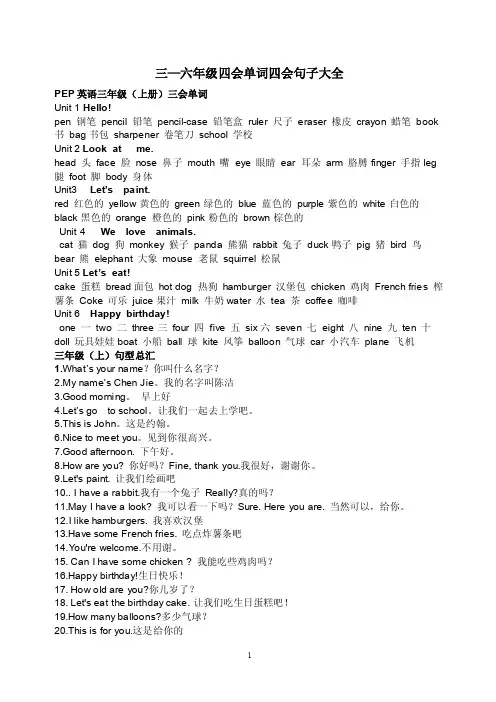
三—六年级四会单词四会句子大全PEP英语三年级(上册)三会单词Unit 1H ello!pen钢笔pencil铅笔pencil-case 铅笔盒r uler 尺子er aser 橡皮cr ayon 蜡笔bo ok 书bag 书包sharpene r 卷笔刀scho ol 学校Uni t 2 Look at me.h ead 头face脸nose 鼻子mouth 嘴e ye 眼睛ear耳朵arm 胳膊finger 手指leg 腿foot脚body 身体Unit3 Let’s pai nt.red 红色的yellow 黄色的green 绿色的blue 蓝色的purple 紫色的white 白色的black 黑色的orange橙色的pink 粉色的brown 棕色的Unit 4We lov e animals.cat 猫d og 狗monke y 猴子panda熊猫rabbit兔子duck 鸭子pig 猪bi rd 鸟bear熊elephant大象mouse老鼠squirre l 松鼠Unit 5 Let’s eat!cake蛋糕bread 面包hot dog热狗hamburg er 汉堡包chi cken 鸡肉Fr ench fries榨薯条Coke可乐juice 果汁milk 牛奶water 水te a 茶coffee咖啡Unit6 Happy birthday!one 一two二three 三four 四fi ve 五six 六seven 七e ight 八nin e 九ten 十doll 玩具娃娃boat 小船ba ll 球kite风筝balloon气球car 小汽车plane 飞机三年级(上)句型总汇1.What’s your nam e?你叫什么名字?2.My name’s Chen Ji e。
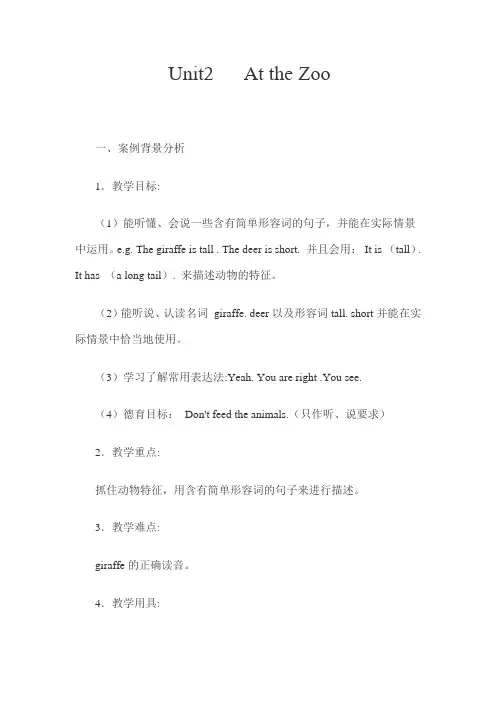
Unit2 At the Zoo一、案例背景分析1.教学目标:(1)能听懂、会说一些含有简单形容词的句子,并能在实际情景中运用。
e.g. The giraffe is tall . The deer is short. 并且会用:It is (tall). It has (a long tail). 来描述动物的特征。
(2)能听说、认读名词giraffe. deer以及形容词tall. short并能在实际情景中恰当地使用。
(3)学习了解常用表达法:Yeah. You are right .You see.(4)德育目标:Don't feed the animals.(只作听、说要求)2.教学重点:抓住动物特征,用含有简单形容词的句子来进行描述。
3.教学难点:giraffe的正确读音。
4.教学用具:自制的各种小动物图片、一颗大树的图片、四张装饰成动物园的吹塑纸板、图钉、动物园门、录音机、写有"Don't feed the animals"的牌子、词卡、Amy and her dad's picture, a short pencil and a long ruler.二、教学过程:Step1.课前交流:分组: T: Boys and girls, I'm Miss Li. I'm your friend .In this class, I'll divide you into four groups.Step 2.Warm-up1.Let's do (P.61)T: Group 1 and Group 2 do actions first, then Group 3 and Group 4.2.(Show the cards : big ,small, long, short )T: Look at the cards, read and do actions.(设计思路:通过丰富形象的形体语言,帮助学生复习、理解、巩固这些形容词,使学生绕有兴趣的在不知不觉中进入所涉及到的话题。
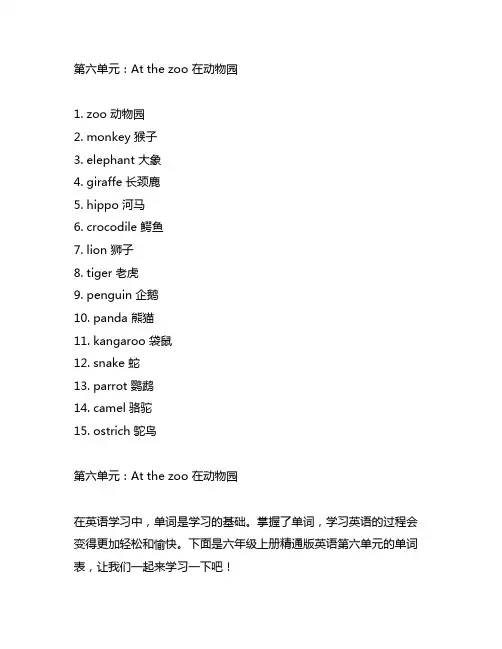
第六单元:At the zoo 在动物园1. zoo 动物园2. monkey 猴子3. elephant 大象4. giraffe 长颈鹿5. hippo 河马6. crocodile 鳄鱼7. lion 狮子8. tiger 老虎9. penguin 企鹅10. panda 熊猫11. kangaroo 袋鼠12. snake 蛇13. parrot 鹦鹉14. camel 骆驼15. ostrich 鸵鸟第六单元:At the zoo 在动物园在英语学习中,单词是学习的基础。
掌握了单词,学习英语的过程会变得更加轻松和愉快。
下面是六年级上册精通版英语第六单元的单词表,让我们一起来学习一下吧!1. zoo 动物园动物园是孩子们喜欢的地方,那里有各种各样的动物,它们来自不同的国家,让我们一起去动物园看看吧!2. monkey 猴子猴子是一种可爱的动物,它们活泼好动,喜欢在树上跳跃。
在动物园里,你一定会看到很多可爱的猴子。
3. elephant 大象大象是世界上最大的陆地动物,它们有着大大的耳朵和长长的鼻子。
在动物园里,你可以骑大象,感受大自然的魅力。
4. giraffe 长颈鹿长颈鹿是非常特别的动物,它们有着长长的脖子和美丽的斑纹。
在动物园里,你一定会被它们迷人的外形所吸引。
5. hippo 河马河马是一种又大又胖的动物,它们喜欢在水中游泳,非常可爱。
在动物园里,你可以看到它们在水池里嬉戏玩耍。
6. crocodile 鳄鱼鳄鱼是一种凶猛的动物,它们的大嘴和锋利的牙齿让人印象深刻。
在动物园里,你可以近距离观察这些神秘的动物。
7. lion 狮子狮子是草原之王,它们威武而勇猛。
在动物园里,你可以看到狮子在阳光下悠闲地打盹,非常壮观。
8. tiger 老虎老虎是世界上最大的猫科动物,它们的身姿优美而矫健。
在动物园里,你可以看到老虎在草地上奔跑,展现它们的美丽身姿。
9. penguin 企鹅企鹅是南极的特有动物,它们有着黑白相间的羽毛,非常可爱。
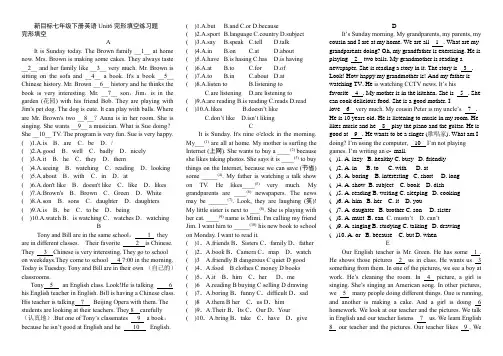
新目标七年级下册英语Unit6完形填空练习题完形填空AIt is Sunday today. The Brown family __1__ at home now. Mrs. Brown is making some cakes. They always taste __2__ and her family like __3__ very much. Mr. Brown is sitting on the sofa and __4__ a book. It's a book __5__ Chinese history. Mr. Brown __6__ history and he thinks the book is very interesting. Mr. __7__ son,Jim,is in the garden (花园) with his friend Bob. They are playing with Jim's pet dog. The dog is cute. It can play with balls. Where are Mr. Brown's two __8__?Anna is in her room. She is singing. She wants __9__ a musician. What is Sue doing?She __10__ TV. The program is very fun. Sue is very happy. ( )1.A.is B.are C.be D./( )2.A.good B.well C.badly D.nicely( )3.A.it B.he C.they D.them( )4.A.seeing B.watching C.reading D.looking ( )5.A.about B.with C.in D.at( )6.A.don't like B.doesn't like C.like D.likes ( )7.A.Brown's B.Brown C.Green D.White ( )8.A.son B.sons C.daughter D.daughters ( )9.A.is B.be C.to be D.being( )10.A.watch B.is watching C.watches D.watchingBTony and Bill are in the same school, 1 they are in different classes. Their favorite 2 is Chinese. They 3 Chinese is very interesting. They go to school on weekdays.They come to school 4 7:00 in the morning. Today is Tuesday. Tony and Bill are in their own (自己的)classrooms.Tony 5 an English class. Look!He is talking 6 his English teacher in English. Bill is having a Chinese class. His teacher is talking 7 Beijing Opera with them. The students are looking at their teachers. They 8 carefully (认真地).But one of Tony’s classmates 9 a book,because he isn’t good at English and he 10 English.( )1.A.but B.and C.or D.because( )2.A.sport nguage C.country D.subject( )3.A.say B.speak C.tell D.talk( )4.A.in B.on C.at D.about( )5.A.have B.is hasing C.has D.is having( )6.A.at B.to C.for D.of( )7.A.to B.in C.about D.at( )8.A.listen to B.listening toC.are listeningD.are listening to( )9.A.are reading B.is reading C.reads D.read( )10.A.likes B.doesn’t likeC.don’t likeD.isn’t likingCIt is Sunday. It's nine o'clock in the morning.My___(1) are all at home. My mother is surfing theInternet (上网). She wants to buy a ____(2) becauseshe likes taking photos. She says it is ____(3) to buythings on the Internet, because we can save (节省)some _____(4). My father is watching a talk showon TV. He likes____(5)very much. Mygrandparents are ____(6)newspapers. The newsmay be ______(7). Look, they are laughing (笑)!My little sister is next to ___(8). She is playing withher cat. ____(9) name is Mimi. I'm calling my friendJim. I want him to _____(10) his new book to schoolon Monday. I want to read it.( )1.A.friends B.Sisters C.family D.father( )2.A.book B.Camera C.map D.watch( )3 A.friendly B dangerous C quiet D good( )4.A.food B clothes C money D books( )5.A.it B.him C.her D.me( )6 A.reading B buying C selling D drawing( )7.A.boring B.funny C.difficult D.sad( )8 A.them B her C.us D.him( )9.A.Their B.Its C.Our D.Your( )10.A.bring B.take C.have D.giveDIt’s Sunday morning. My grandparents, my parents, mycousin and I are at my home. We are all 1 . What are mygrandparents doing? Oh, my grandfather is exercising. He isplaying 2 two balls. My grandmother is reading anewspaper. She is reading a story in it. The story is 3 .Look! How happy my grandmother is! And my father iswatching TV. He is watching CCTV news. It’s hisfavorite 4 . My mother is in the kitchen. She is 5 . Shecan cook delicious food. She is a good mother. Ilove 6 very much. My cousin Peter is my uncle’s 7 .He is 10 years old. He is listening to music in my room. Helikes music and he 8 play the piano and the guitar. He isgood at 9 . He wants to be a singer (歌唱家). What am Idoing? I’m using the computer, 10 I’m not playinggames. I’m writing an e⁃mail.( )1. A. lazy B. healthy C. busy D. friendly( )2. A. in B. to C. with D. at( )3. A. boring B. interesting C. short D. long( )4. A. show B. subject C. book D. dish( )5. A. reading B. writing C. sleeping D. cooking( )6. A. him B. her C. it D. you( )7. A. daughter B. brother C. son D. sister( )8. A. must B. can C. mustn’t D. can’t( )9. A. singing B. studying C. talking D. drawing( )10. A. or B. because C. but D. whenEOur English teacher is Mr. Green. He has some 1 .He shows those pictures 2 us in class. He wants us 3something from them. In one of the pictures, we see a boy atwork. He’s cleaning the room. In 4 picture, a girl issinging. She’s singing an American song. In other pictures,we 5 many people doing different things. One is running,and another is making a cake. And a girl is doing 6homework. We look at our teacher and the pictures. We talkin English and our teacher listens 7 us. We learn English8 our teacher and the pictures. Our teacher likes 9 . Welike him and his 10 , too.( )1.A.picture B.a picture C.pictures D.an picture ( )2.A.for B.with C.to D.from( )3.A.learn B.learns C.learning D.to learn ( )4.A.others B.the other C.another D.the others ( )5.A.look B.read C.see D.watch( )6.A.my B.your C.her D.his( )7.A.to B.with C.at D.for( )8.A.to B.from C.with D.for( )9.A.we C.I D.me( )10.A.classs B.classes C.school D.classroomFOnce upon a time(从前),there was 1 old farmer. He loved money very much. He kept a lot of gold coins(金币)but 2 used them; he 3 not give them to others. He put them into a 4 box and put it in the ground. He came to the 5 every day to look at it. This made him happy.6 , when he came to the place, he could not find the7 .He became very, very sad. He began to cry.8 a man came to him and said,“Don’t cry. Put a stone (石头)in the ground instead, and9 it is a box of gold coins. A stone will be still the same 10 when the coins were there, you never used them.”( )1. A. a B. the C. an D. /( )2. A. often B. never C. nearly D. almost( )3. A. did B. could C. must D. should( )4. A. black B. paper C. blue D. strong( )5. A. earth B. ground C. place D. there( )6. A. After day B. SometimesC. One dayD. From then on( )7. A. box B. money C. place D. house( )8. A. So B. Then C. But D. And( )9. A. say B. let C. think D. know( )10. A. so B. because C. and D. whyGthe sun is shining and it’s very hot. 1 many people don’t want to go out after 2 . Mrs West hasto(不得不) 3 her father at the airport. Herfather doesn’t feel well, he wants to see a 4 inthe city hospital.Now she’s 5 in the street. there 6no trees and she feels very 7 . But she’s too8 and can’t walk fast(快). Suddenly she finds(发现) a 9 walking behind her. She gets angryand her face turns red. “Why are you walking 10me, boy?” She asks strictly. “It’s cooler”. the boyanswers.( )1、A But B Because C So D then( )2、A breakfast B dinner C supper D lunch( )3、A watch B meet C help D ask( )4、A nurse B waiter C policeman D doctor( )5、A walking B walks C walk D to walk( )6、A be B、is C、are D、am( )7、A cold B cool C relaxed D hot( )8、A happy B fat C short D tall( )9、A boy B man C woman D dog( )10、A on B in front of C behind D across fromHIt's the eve (前夕) of Chinese New Year. Jim'sparents are__1__. His father is cleaning the house.His mother is__2__ delicious jiaozi. They are ready(准备好) for the__3__. And they are waiting for(等待) Jim to come back home, too.__4__is Jim now? He is on the way backhome. His parents want him to come back__5__.But he meets a woman on the way home. Thewoman looks worried (焦虑的),and she asks himto__6__her. She says she is also going home, buther__7__is broken (损坏的). After hearing herwords (话),Jim puts her bike into his car and__8__her home.When Jim gets home, his parents are__9__waiting for him. He tells them what happens(发生) on the way back home. They are very__10__to knowwhat he does. Then the family have a big dinner together.()1. A. at school B. at homeC. at the zooD. at the supermarket()2. A. having B. selling C. buying D. making()3. A. trip B. test C. festival D. party()4. A. Who B. How C. Where D. What()5. A. late B. quickly C. usually D. really()6. A. help B. forget C. use D. miss()7. A. car B. bike C. train D. subway()8. A. walks B. drives C. keeps D. follows()9. A. just B. never C. also D. still()10. A. sorry B. quiet C. happy D. afraidIAn old woman is going ____1 with a basket(篮子).She is going ___2 boat. The boat is going across (穿过) theriver. Her basket is ____3 now. Oh dear! Look! Her basketis in the water. “Help! My basket is in the river!” thewoman ____4.A boy sees the basket. He says, “____5! I can ____6. Ican get it ___7 you!” He takes off (脱下) his shirt andshoes.“___8 them for me, please!” he says, and gets intothe river.A duck(鸭子) sees the basket. It says, “I can go byboat.” It ____9 the basket is a boat. It gets ___10 the basket.The boy is swimming in the river. “Where's thebasket?” he asks. “It's over there!” says the woman. “It's____11 that duck!” The boy gets to the basket. “Go away!”he says to the duck. The duck comes out of the basket andswims ____12.The boy takes the basket back to the woman. “Oh,thank you very much, ” says the woman. “Not at all!” saysthe boy. “Do you have _____13 shirt and shoes, please?”“Yes, _____14 you are. Oh! _____15 is this in the basket?”“It's the duck's egg!”( )1. A. shopping B. running C. swimming D. coming( )2. A. on B. in C. by D. from( )3. A. empty B. full C. heavy D. high( )4. A. says B. speaks C. talks D. listens( )5. A. Look out B. Don't worryC. Excuse meD. Not at all( )6. A. run B. jump C. lie D. swim( )7. A. of B. for C. from D. off( )8. A. Look for B. Look intoC. Look likeD. Look after( )9. A. thinks B. smiles C. says D. likes( )10. A. from B. into C. out D. over( )11. A. on B. over C. under D. off( )12. A. in B. away C. on D. of( )13. A. my B. his C. your D. its( )14. A. there B. here C. over D. where( )15. A. Where B. Why C. What D. HowJLook, this is a photo of my family. There are 1 people in the photo — my father, my mother, my sister and I. Weare 2 in a park (公园). My father is playing basketball. Basketball is his favorite 3 . My mother is 4 a newspaper. The newspaper seems (好像) very 5 . She keeps a smile (微笑). I’m playing with my pet dog. Ilike 6 best. My sister is playing 7 violin. She practices the violin 8 one hour every day. She can play it well and she is a member of the school 9 club. We are all 10 a good time.( )1. A. three B. four C. five D. six( )2. A. working B. exercising C. relaxing D. studying ( )3. A. color B. subject C. sport D. job( )4. A. watching B. looking C. seeing D. reading( )5. A. interesting B. boring C. easy D. difficult( )6. A. pandas B. dogs C. cats D. koalas( )7. A. a B. an C. the D. 不填( )8. A. at B. with C. in D. for( )9. A. chess B. music C. English D. swimming( )10. A. doing B. having C. making D. takingKA fox is1food. He is very hungry. Now he 2near a wall. The wall is very3. The fox is looking up. He sees4fine grapes5the wall. He smiles and says, “6nice they are! I want to eat them. ”The fox is jumping. He jumps and jumps, 7the wall is too high. He8get the grapes. The fox says, “I must go now. I don’t like those grapes. 9are green. They are not10to eat. ”( )1. A. seeing B. finding outC. looking forD. finding( )2. A. gets B. comes C. goes D. stands ( )3. A. much B. small C. strong D. high( )4. A. a little B. few C. much D. a lot of ( )5. A. in B. on C. at D. for( )6. A. What B. How C. What a D. How a ( )7. A. and B. or C. but D. where( )8. A. can’t B. can C. hasn’t D. isn’t ( )9. A. We B. It C. You D. They ( )10. A. bad B. good C. hard D. better参考答案A 1-5 BADCA 6-10 DADCBB 1-5 ADACD 6-10 BCCBBC 1~5CBDCA6~10ABABBD 1-5 CCBAD 6-10 BCBACE 1~5 CCDCC 6~10 CABBBF 1-5 CBADC 6-10 CABCBG 1-5CDBDA 6-10 CDBACH 1~5:BDCCB6~10:ABBDCI 1-5 ACAAB 6-10 DBDAB 11-15 CBABCJ 1-5 BCCDA 6-10 BCDBBK 1~5. CDDDB6~10. BCADB。
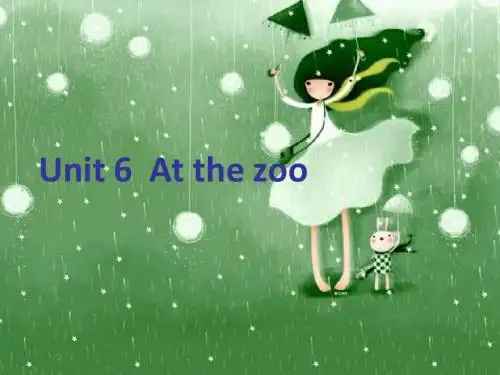
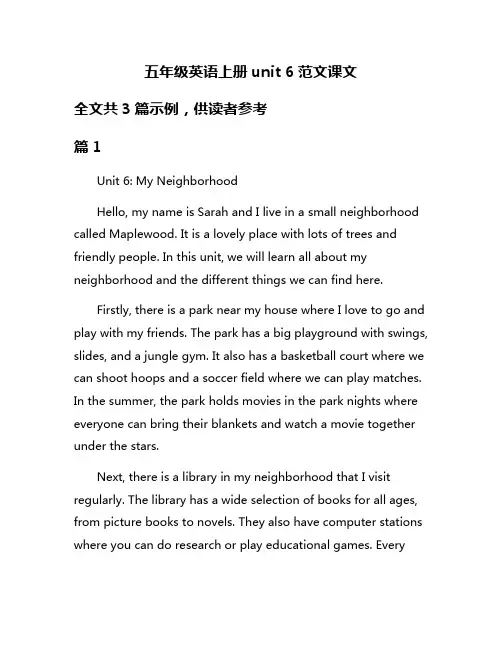
五年级英语上册unit 6范文课文全文共3篇示例,供读者参考篇1Unit 6: My NeighborhoodHello, my name is Sarah and I live in a small neighborhood called Maplewood. It is a lovely place with lots of trees and friendly people. In this unit, we will learn all about my neighborhood and the different things we can find here.Firstly, there is a park near my house where I love to go and play with my friends. The park has a big playground with swings, slides, and a jungle gym. It also has a basketball court where we can shoot hoops and a soccer field where we can play matches. In the summer, the park holds movies in the park nights where everyone can bring their blankets and watch a movie together under the stars.Next, there is a library in my neighborhood that I visit regularly. The library has a wide selection of books for all ages, from picture books to novels. They also have computer stations where you can do research or play educational games. Everymonth, the library hosts a reading challenge where you can win prizes for reading a certain number of books.There are also a few small shops in my neighborhood where you can buy everything you need. There is a grocery store where my mom buys our food, a bakery that sells delicious pastries, and a pet store where you can buy food and toys for your pets. There is also a farmer's market that comes once a week where you can buy fresh fruits and vegetables.Lastly, there is a community center in my neighborhood where people can go to take classes or workshops. They offer art classes, dance classes, cooking classes, and even fitness classes. They also organize community events like charity fundraisers and holiday celebrations.I love my neighborhood because it has everything I need and everyone is so friendly. I hope you enjoyed learning all about Maplewood with me. Thank you for reading!篇2Unit 6: A Day at the ZooToday, the fifth grade students went on a field trip to the zoo. The weather was perfect for a day outdoors, and the students were all excited to see the animals up close.As soon as we arrived at the zoo, we split into small groups and set off to explore the different sections. Some students went to see the lions, while others went to visit the monkeys. I decided to start at the elephant enclosure.The elephants were huge and majestic creatures. They were busy playing with each other and munching on leaves. I watched in awe as they moved around gracefully, their trunks swaying back and forth. One of the elephants even sprayed water on itself with its trunk, much to the delight of the onlookers.After spending some time at the elephant enclosure, I moved on to see the giraffes. These tall creatures were captivating to watch as they stretched their long necks to reach the leaves on the trees. I learned that giraffes have a blue-black tongue that is almost 20 inches long, which helps them pluck leaves from the tallest branches.Next, I made my way to the reptile house. Inside, I saw snakes, lizards, and turtles of all shapes and sizes. The students were fascinated by the snakes and their slithering movements. I even got to touch a turtle shell, which was hard and bumpy to the touch.As we continued our tour of the zoo, we came across the bird aviary. There were parrots, cockatoos, and even a toucan.The students were amazed by the bright colors and beautiful feathers of the birds. I even got to feed a parrot some seeds, and it nuzzled my hand in gratitude.Finally, we made our way to the petting zoo area. There were goats, sheep, and even a baby cow. The students had a blast petting the animals and feeding them grass. I was surprised at how friendly and gentle the animals were, despite having so many visitors throughout the day.As the day came to an end, we gathered together for a group photo at the entrance of the zoo. We were all tired but happy after a day filled with fun and learning. The fifth grade students had a fantastic time at the zoo, and it was a day they would never forget.Overall, the field trip was a great success, and it was a wonderful opportunity for the students to learn about animals in a hands-on way. I'm sure they will remember this day at the zoo for years to come.篇3Unit 6: Animals in DangerText 1:The giant panda is in danger. It’s from China. It is very lovely. It’s black and white. But it’s not very big. It’s only about 1.5 meters long.It eats bamboo leaves. It eats about 20 kilos of bamboo leaves every day. There are only about 1,000 giant pandas in the world.The koala is in danger too. It’s from Australia. It’s a marsupial. It’s not a bear. It’s about 60 centimeters long. It eats eucalyptus leaves. There are only about 80,000 koalas in Australia now.Text 2:The Siberian tiger is in great danger too. It’s from Russia. It’s the biggest tiger in the world. It’s about 3 meters long. It weighs about 300 kilos.The Siberian tiger is very strong. It eats meat. There are only about 300 Siberian tigers in Russia now.The mountain gorilla is a kind of monkey. It’s in danger too. It’s from Africa. It’s about 1.8 meters tall. It’s very clever. It eats leaves and fruit. There are only about 700 mountain gorillas in the world.Text 3:The blue whale is t he largest animal in the world. It’s in danger. There are only about 10,000 blue whales left. They live in the ocean.The orangutan is in great danger too. It’s from Indonesia and Malaysia. It’s a kind of ape. It’s very like a human. There are only about 40,000 orangutans in the world.Many animals are in danger today. We must help them. We should love them and protect them.---I hope the above content meets your requirements. Let me know if you need any changes or further information.。
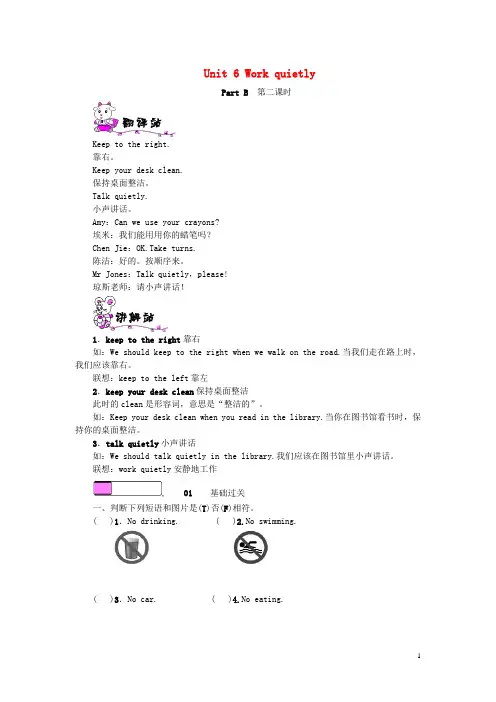
Unit 6 Work quietlyPart B第二课时Keep to the right.靠右。
Keep your desk clean.保持桌面整洁。
Talk quietly.小声讲话。
Amy:Can we use your crayons?埃米:我们能用用你的蜡笔吗?Chen Jie:OK.Take turns.陈洁:好的。
按顺序来。
Mr Jones:Talk quietly,please!琼斯老师:请小声讲话!1.keep to the right靠右如:We should keep to the right when we walk on the road.当我们走在路上时,我们应该靠右。
联想:keep to the left靠左2.keep your desk clean保持桌面整洁此时的clean是形容词,意思是“整洁的”。
如:Keep your desk clean when you read in the library.当你在图书馆看书时,保持你的桌面整洁。
3.talk quietly小声讲话如:We should talk quietly in the library.我们应该在图书馆里小声讲话。
联想:work quietly安静地工作, 01基础过关一、判断下列短语和图片是(T)否(F)相符。
( )1.No drinking. ( )2.No swimming.( )3.No car. ( )4.No eating.二、根据情境,选择对应的内容。
( )1.They are playing a game. A.Talk quietly.( )2.John is talking in the library. B.Work quietly.( )3.We are writing in class. C.Take turns.( )4.They are walking on the road. D.Keep to the right.( )5.Amy is colouring at her desk. E.Keep the desk clean., 02能力提升三、看图片,写短语,补全句子。
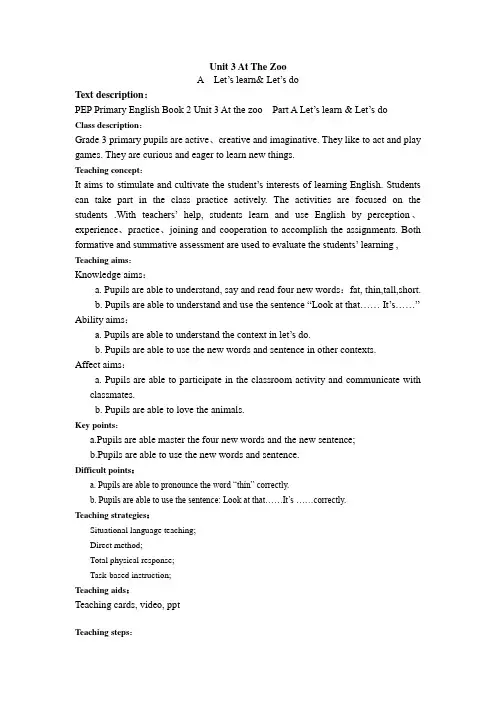
Unit 3 At The ZooA Let’s learn& Let’s doText description:PEP Primary English Book 2 Unit 3 At the zoo Part A Let’s learn & Let’s doClass description:Grade 3 primary pupils are active、creative and imaginative. They like to act and play games. They are curious and eager to learn new things.Teaching concept:It aims to stimulate and cultivate the student’s interests of learning English. Students can take part in the class practice actively. The activities are focused on the students .With teachers’ hel p, students learn and use English by perception、experience、practice、joining and cooperation to accomplish the assignments. Both formative and summative assessment are used to evaluate the students’ learning , Teaching aims:Knowledge aims:a. Pupils are able to understand, say and read four new words:fat, thin,tall,short.b. Pupils are able to understand and use the sentence “Look at that…… It’s……”Ability aims:a. Pupils are able to understand the context in let’s do.b. Pupils are able to use the new words and sentence in other contexts.Affect aims:a. Pupils are able to participate in the classroom activity and communicate withclassmates.b. Pupils are able to love the animals.Key points:a.Pupils are able master the four new words and the new sentence;b.Pupils are able to use the new words and sentence.Difficult points:a. Pupils are able to pronounce the word “thin” correctly.b. Pupils are able to use the sentence: Look at that……It’s ……correctly.Teaching strategies:Situational language teaching;Direct method;Total physical response;Task-based instruction;Teaching aids:Teaching cards, video, pptTeaching steps:。
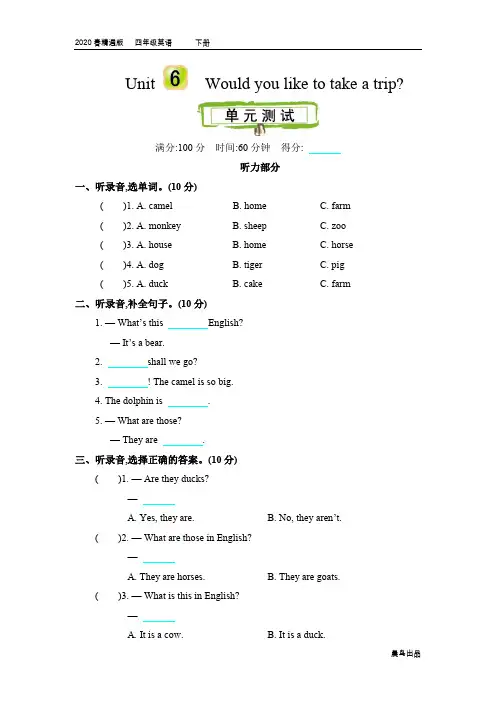
Unit Would you like to take a trip?满分:100分时间:60分钟得分:听力部分一、听录音,选单词。
(10分)()1. A. camel B. home C. farm()2. A. monkey B. sheep C. zoo()3. A. house B. home C. horse()4. A. dog B. tiger C. pig()5. A. duck B. cake C. farm二、听录音,补全句子。
(10分)1. — What’s this English?— It’s a bear.2. shall we go?3. ! The camel is so big.4. The dolphin is .5. — What are those?— They are .三、听录音,选择正确的答案。
(10分)()1. — Are they ducks?—A. Yes, they are.B. No, they aren’t.()2. — What are those in English?—A. They are horses.B. They are goats.()3. — What is this in English?—A. It is a cow.B. It is a duck.()4. — What are these in English?—A. They are dogs.B. They are pigs.()5. — Where shall we go?—A. We want to go to the Great Wall.B. We want to go to Shanghai.四、听录音,给句子排序。
(10分)()They are giraffes.()What are these?()Wow, they are beautiful.()No, they are giraffes.()Are these horses?笔试部分五、看图,完成句子。
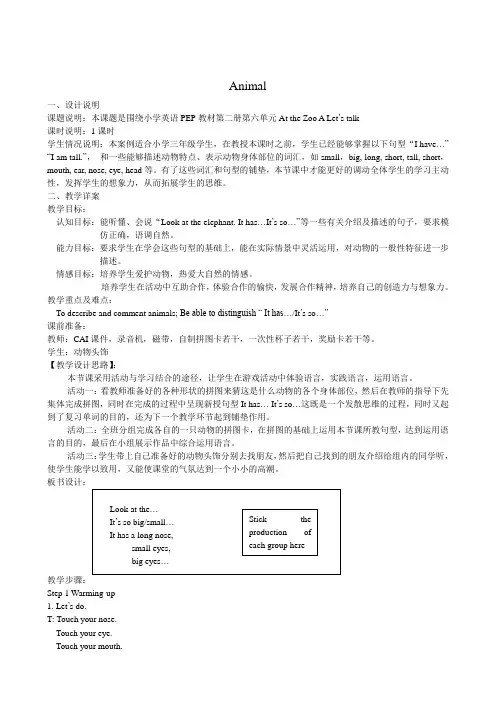
Animal一、设计说明课题说明:本课题是围绕小学英语PEP教材第二册第六单元At the Zoo A Let’s talk课时说明:1课时学生情况说明:本案例适合小学三年级学生,在教授本课时之前,学生已经能够掌握以下句型“I have…”“I am tall.”,和一些能够描述动物特点、表示动物身体部位的词汇,如small,big, long, short, tall, short,mouth, ear, nose, eye, head等。
有了这些词汇和句型的铺垫,本节课中才能更好的调动全体学生的学习主动性,发挥学生的想象力,从而拓展学生的思维。
二、教学详案教学目标:认知目标:能听懂、会说“Look at the elephant. It has…It’s so…”等一些有关介绍及描述的句子,要求模仿正确,语调自然。
能力目标:要求学生在学会这些句型的基础上,能在实际情景中灵活运用,对动物的一般性特征进一步描述。
情感目标:培养学生爱护动物,热爱大自然的情感。
培养学生在活动中互助合作,体验合作的愉快,发展合作精神,培养自己的创造力与想象力。
教学重点及难点:To describe and comment animals; Be able to distinguish “It has…/It’s so…”课前准备:教师:CAI课件,录音机,磁带,自制拼图卡若干,一次性杯子若干,奖励卡若干等。
学生:动物头饰【教学设计思路】:本节课采用活动与学习结合的途径,让学生在游戏活动中体验语言,实践语言,运用语言。
活动一:看教师准备好的各种形状的拼图来猜这是什么动物的各个身体部位,然后在教师的指导下先集体完成拼图,同时在完成的过程中呈现新授句型It has… It’s so…这既是一个发散思维的过程,同时又起到了复习单词的目的,还为下一个教学环节起到铺垫作用。
活动二:全班分组完成各自的一只动物的拼图卡,在拼图的基础上运用本节课所教句型,达到运用语言的目的,最后在小组展示作品中综合运用语言。
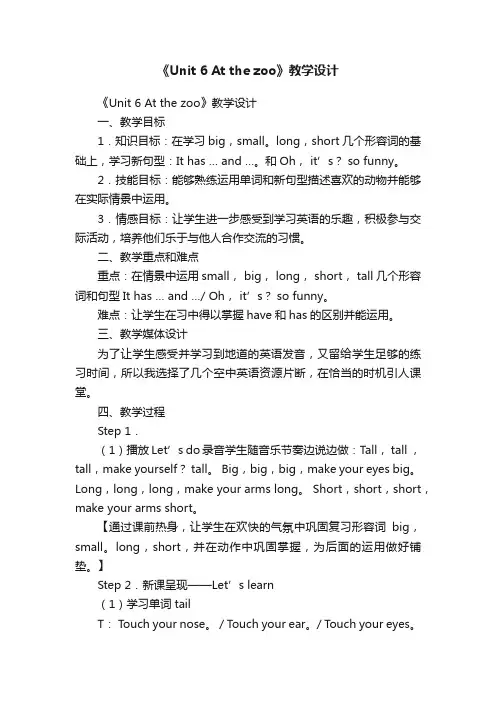
《Unit 6 At the zoo》教学设计《Unit 6 At the zoo》教学设计一、教学目标1.知识目标:在学习big,small。
long,short几个形容词的基础上,学习新句型:It has … and …。
和Oh,it’s? so funny。
2.技能目标:能够熟练运用单词和新句型描述喜欢的动物并能够在实际情景中运用。
3.情感目标:让学生进一步感受到学习英语的乐趣,积极参与交际活动,培养他们乐于与他人合作交流的习惯。
二、教学重点和难点重点:在情景中运用small, big, long, short, tall几个形容词和句型It has … and …/ Oh,it’s? so funny。
难点:让学生在习中得以掌握have和has的区别并能运用。
三、教学媒体设计为了让学生感受并学习到地道的英语发音,又留给学生足够的练习时间,所以我选择了几个空中英语资源片断,在恰当的时机引人课堂。
四、教学过程Step 1.(1)播放Let’s do录音学生随音乐节奏边说边做:Tall, tall ,tall,make yourself? tall。
Big,big,big,make your eyes big。
Long,long,long,make your arms long。
Short,short,short,make your arms short。
【通过课前热身,让学生在欢快的气氛中巩固复习形容词big,small。
long,short,并在动作中巩固掌握,为后面的运用做好铺垫。
】Step 2.新课呈现——Let’s learn(1)学习单词tailT: Touch your nose。
/ Touch your ear。
/ Touch your eyes。
/? Touch your mouth。
学生随教师的指令作出相应的动作。
T:Touch your tail。
听到这个指令,学生不解,师适时教单词tail 。
PEP 小学英语三年级下册Unit 6 At the zooB Let’s talk.Type: NewTheme:Talking about the animals in the zoo.Text analysis:这是一节对话课。
讲述的是学生到动物园看各种不同体态特征的动物,并对它们的体型作对比来学习形容词。
B部分以A部分的对话为基础,进一步描述动物园的动物。
The analysis of the students ’ situation:本节课的授课对象为小学三年级学生,他们生性活泼好动,好奇心强,喜欢自我表现,但部分学生上课时容易分散注意力。
因此,如何吸引学生的注意力,让学生积极参与课堂活动是本节课的关键。
在这节课中我采用了竞赛积分、游戏、动静结合等教学方式,来带动学生学习积极性、从而培养学生学习兴趣。
Teaching design:我结合教材与学情分析,为了更好地实现教学目标,充分设计生活情景,去参观动物园,选拔优秀导游为主线,来调动学生的情绪和参与的热情,让他们学会在实际情境中利用所学短语,鼓励学生在真实情境中会话。
主要采取师生、生生互相合作,学生在愉快的学习氛围中习得知识。
Teaching aims and demands:1. Knowledge aims:1) Students are able to listen, read and speak new words:giraffe , deer, big, small, long, tall, short2) Students are able to understand the sentence:Look at the elephant. It‟s so big. It has …The giraffe is tall. The deer is short. I‟m short. You are tall.Yeah! You‟re right.2. Ability aims:1) To develop Ss‟abilities of listening, speaking and recognizing the new words.2) Students are able to understand and use the sentence pattern in real situations correctly.3. Affect aims:1) To foster Ss‟ consciousness of proper competition and good cooperation.2) Guide the students to protect the animals and love the nature.Key points:Students can recognize the words and express the new sentences. Difficult points:1. Students are able to pronounce the new words correctly: giraffe tall and so on.2. To describe the animals fluently in proper context.Teaching strategies:1. Show the PPT and make the English class visual.2. Prepare some word cards and help students recognize the words.3. Lead the students sing and chant,Stimulate students interest in learning.4. Design some activities and practice students‟English application ability‟Teaching tools:Multi-media , word cards, animal pictures, colorful pens,Teaching Steps:Step1: Warm up1. Greetings.And have a free talk.2. Say the chant of Book1 unit4 Part B: Look at the cat. It is fat…The teacher loads the students clap hands and sat the chant together. Encourage the students to enter the English world.【设计意图:在热身环节中说唱关于动物的chant,不仅活跃了气氛,创设了语言的情境,同时从chant中导出动物主题,为教学主线做准备。
PEP小学英语三年级上册Unit6单元整体教学设计Unit 6: At the ZooOutline:1. Theme: Visiting the Zoo2. objectives:a. To develop an understanding of animals at the zoob. To develop listening and speaking skillsc. To use adjectives to describe animals3. Materials needed:a. Pictures of animals at the zoob. Animal flashcardsc. Animal bookd. Worksheets for practice4. Teaching Plan:Week 1Day 1: Introduction to the Zoo- The teacher will show pictures of different animals at the zoo and ask students if they have been to one.- The teacher will introduce new vocabulary words such as lion, tiger, elephant, monkey etc.- Students will be given worksheets to practice the vocabulary. Day 2: Reading comprehension- Teacher will read a story from the animal book and ask questions to assess understanding.- Students will work in groups to create a picture of a zoo using their new vocabulary words.Day 3: Writing Practice- Teacher will teach students how to write simple sentences using the words learned.- The teacher will provide a worksheet with prompts to help them write sentences.Day 4-5: Speaking Practice- Students will work in pairs and take turns pretending to be a tour guide and visitor at the zoo.- They will practice asking and answering questions related to the zoo.Week 2Day 1: Adjectives- Teacher will introduce adjectives using sentences like "the big elephant" and "the small monkey" to describe animals.- Students will play an adjective game to practice using different adjectives to describe the animals.Day 2: Listening Comprehension- Students will listen to animal sounds and match them to the appropriate animal picture.- They will then be asked to share the sounds they heard and connect them to the animal.Day 3: Role Play- Students will work in groups to create their own zoo and come up with a story to tell visitors.- They will present their zoo story in class.Day 4-5: Review and Assessment- The teacher will provide a review test to assess students' understanding of the unit.- Students will also be given time to reflect on what they learned and what aspects they need to work on further.5. ConclusionThrough this unit, students will develop a greater understanding of animals, improve their listening and speaking skills, and learn adjectives to describe animals at the zoo. By the end of the unit, students will be able to effectively communicate and share their knowledge with others.In addition to the activities outlined in the teaching plan, there are many other ways teachers can enhance students' learning experience during the zoo unit.One way to keep students engaged is by incorporating technology into the classroom. Teachers can use videos or images of animals at the zoo to give students a virtual tour. This can help students who have never been to a zoo before get a better understanding of what they will see there.Another way to get students involved is to plan a field trip to a local zoo. Seeing the animals up close can make the learning experience more memorable and help students apply what they have learned in the classroom to real-life situations.Teachers can also connect this unit to other subjects such as science and social studies. Students can learn about the habitats of the animals, their diets, and how they interact with each other. This can lead to discussions about conservation and the impact ofhumans on the environment.To make the experience even more immersive, teachers can create a classroom zoo. Students can work together to create a diorama of different animal habitats or make animal puppets to act out stories they have learned in class. This hands-on activity can help students develop creativity and teamwork skills.It is also important to be mindful of the diversity within the classroom. Teachers can incorporate books or videos about animals from different countries or cultures. This can help students connect with their own cultural backgrounds and learn about those of their peers.Finally, teachers should remember that it is important to make learning fun. Incorporating games and activities into the unit can help students stay engaged and excited about learning. Teachers can create bingo boards with different animal pictures or have students work in teams to complete animal-themed challenges.In conclusion, the zoo unit can be a fun and enriching learning experience for students. By incorporating a variety of activities and technologies, making connections to other subjects, and being mindful of diversity, teachers can create a memorable and impactful learning experience for their students.In addition to the ideas mentioned above, teachers can encourage critical thinking and inquiry by having students conduct research projects about specific animals or animal habitats. This can be done individually or in small groups and can be presented in the form of a poster, report, or multimedia presentation.To bring a creative element to the unit, teachers can also have students create their own animal species. This activity can require students to think about the adaptation of animals to their habitats, their diets, and their unique physical characteristics. Students can present their creations to the class, complete with a drawing or model of the animal.To expand on the concept of habitat preservation, teachers can organize an eco-friendly project where students can learn about eco-friendliness and how it is important for wild animals. A project could involve creating organic wildlife corridors or habitats, promoting urban sustainable farming or designing educational posters on the subject.Zoos also have a variety of careers, and teachers can help students understand the different types of jobs and roles in the zoo – not all of them must be zookeepers. By providing students with examples of animal biologists, animal behaviorists, veterinarians, and animal rights activists, teachers can help students think about career possibilities and new career choices.Finally, teachers can create class discussions to talk about the ethical issues surrounding zoos. Zoos can be a controversial topic, and it is important for students to understand all sides of the argument. These discussions can help to prepare students to think critically and develop their skills in making informed ethical decisions.In conclusion, there are endless ways that teachers can enhancetheir zoo unit to make it an immersive and fascinating learning experience. By incorporating a variety of activities, promoting critical thinking and inquiry, and exploring ethical issues, teachers can create an unforgettable unit that not only teaches students about animals but also connects them to the animal kingdom and environmental concerns.教师可以通过多种方式提高学生对动物园学习单元的兴趣和理解。
英语教案-Unit 6 At the zoo 第五课时【课题】Unit 6 At the zoo 第五课时【教学重点】新词:tall short giraffe deer复习本单元所学的形容词。
【教学难点】正确的运用形容词描述事物的特征。
【教具准备】单词卡片。
小动物头饰。
3、教材相配套的教学课件。
4、教材相配套的教学录音带。
【教学过程】热身/复习(Warm-up/Revision)1、Listen and do教师发出口令,(big/small …),孩子听到口令后用动作表演。
2、说反义词教师说small,孩子说出big。
呈现新课(Presentation)1、教师出示Let’s learn部分的挂图,让孩子说说What can you see?让孩子用学过的词描述一下看到的动物。
2、出示Let’s learn部分录像,学生认读tallshort giraffe deer四个单词;教师出示词卡,让孩子用动作表现词义。
3、黑板上贴出所有学过的描述性单词,让孩子把单词和相应的形象连在一起。
然后用完整的句子描述。
教师可告诉学生或让学生自己归纳:单词short有两种意思,所以有两个反义词long和 tall。
4、Sing the song教师在黑板上贴出所有学过的动物图片,让孩子说一说。
听录音,让孩子边听,边上前指出。
听录音,边听边举手中的动物头饰。
小组里表演歌曲,带上头饰表演,边演边唱。
(三)趣味操练(Practice)活动一:听一听,做一做教师出示单词卡片(形容词+物品名称。
如:a long ruler),孩子根据要求,找到物品,最快的获胜。
活动二:Listen and draw听一听,画一画教师用英语说出要求:Draw a big bag/…。
孩子根据要求画出物品,然后小组比一比谁画的好,比一比谁的大,谁的小。
扩展性活动(Add-activities)教师播放动画《Follow me》先让学生观看,然后模仿自己看到的内容活动,可以比赛的形式进行,或做与口令相反的动作,谁作错了就淘汰出局,看谁坚持到最后。
Test for Unit 3Let's ListenⅠ. Listen and choose. 听录音,在所听到的单词后的括号里打"√"。
(10分)1.small( )2. big ( )3. pear( )tall( ) pig ( ) bear( )4. fat( )5. no ( )cat( ) so ( )Ⅱ. listen and number. 听录音,给图片标号。
(10分)( ) ( ) ( ) ( ) ( )Ⅲ. Listen and tick. 听录音,判断,相符的画“”,不相符的画“”。
(10分)1. ( ) 2. ( ) 3. ( )4. ( )5. ( )IV. Listen and number. 听录音,给句子标号。
(10分)()Look at the elephant!()It has a long nose and a short tail.()Come here,children.()Wow! It's so big!()And it has small eyes and big ears.Let’s WriteⅠ. Read and tick. 读单词,判断单词与其汉语意思是"√"否"×"一致。
(5分) 1. fat 猫( ) 2.thin 瘦( ) 3.tall 球( ) 4. short 短的( ) 5. long 长的( )Ⅱ. Read and choose. 选词填空。
(5分)( ) 1.The elephant has a ___________ nose.A. longB. bigC. short( ) 2.The panda has two ____________ eyes.A. whiteB. blueC. black( ) 3.The rabbit has two ____________ ears.A. longB. bigC. small( ) 4. Look at the elephant. It's so ____________.A. bigB. tallC. small( ) 5.I have a squirrel. It has a ___________tail.A. smallB. shortC. bigⅢ. Read and choose. 选词填空。
Unit6 At the zoo. B Let’s lean. Let’s sing.课堂实录教学内容:PEP小学英语三年级下册Unit6 At the zoo. B部分Let’s learn. Let’s sing.教学目标:在Let’s learn.的基础上掌握形容词tall、short以及两个有关动物的名词giraffe、deer。
要求学生能够听、说、认读;本部分通过演唱歌曲,让学生复习和巩固有关动物的词汇。
课前准备:课件、录音机、磁带、动物图片教学过程:一、复习T: It’s time for class.S: Stand up.T: Good morning,boys and girls.S: Good morning,Miss Fan.T: I’m very happy. Because we are going to the farm to see many animals.First,let’s sing a song .(放英文歌曲《Old MacDonald》)T: There are many animals on the farm. How many animals do you know? Can you say their names.S: Cat、dog、rabbit、monkey………T: Oh,very good.Let’ s look at some animal pictures. Please say their names,OK,together.(出示动物课件,生齐说动物名称)二、新授(一)新授giraffe and deerT: Let’s meet a new animal.(出示长颈鹿课件)S: 长颈鹿。
T: Let me tell you. “giraffe”(采用齐读、同桌一组一组读的方式进行操练)T: The giraffe has a good friend . Let’s meet the new friend.(出示deer课件)T: “deer”中的字母组合“eer”与耳朵“ear” 的发音相同。
译林版四年级英语上册unit6教案(实用版)编制人:__________________审核人:__________________审批人:__________________编制单位:__________________编制时间:____年____月____日序言下载提示:该文档是本店铺精心编制而成的,希望大家下载后,能够帮助大家解决实际问题。
文档下载后可定制修改,请根据实际需要进行调整和使用,谢谢!并且,本店铺为大家提供各种类型的实用资料,如工作总结、工作报告、文案策划、工作计划、讲话致辞、合同模板、教案大全、作文大全、心得体会、其他资料等等,想了解不同资料格式和写法,敬请关注!Download tips: This document is carefully compiled by this editor.I hope that after you download it, it can help you solve practical problems. The document can be customized and modified after downloading, please adjust and use it according to actual needs, thank you!And, this store provides various types of practical materials for everyone, such as work summaries, work reports, copywriting plans, work plans, speeches, contract templates, lesson plans, essays, experiences, and other materials. If you want to learn about different data formats and writing methods, please pay attention!译林版四年级英语上册unit6教案Unit 6 Lesson Plan (Module (1)- Fun at the ZooI.Learning Objectives:1.Understand and use vocabulary related to zoo animals。
Unit6 At the Zoo
一教学目标:
1.知识目标:学习形容词big, small,long, short。
2.技能目标:能够熟练运用单词描述喜欢的动物并能够在实际情景中运用。
3.情感目标:让学生进一步感受到学习英语的乐趣,积极参与交际活动,培养他们乐于与他人合作交流的习惯。
二、教学重点和难点
在情景中运用small, big, long, short, tall几个形容词。
三、教学过程
Step1热身Warm-up
播放Let’s do录音学生随音乐节奏边说边做:Tall, tall ,tall, make yourself tall. Big, big, big, make your eyes big. Small, small, small, make your eyes small, Long, long, long, make your arms long. Short, short, short, make your arms short.
Step 2.新课呈现--Let’s learn
T: boys and girls! Do you like animals? Today let’s go to the zoo!
Do you know what’s in the zoo? (复习动物名称)
(1)学习单词small
大屏幕出示一个小圆圈。
T: Guess, what’s it? (apple, orange, ball……)
出示一个小球和单词ball。
T: Oh, it’s a ball. It’s so small.
ball ----small
the ball is small.
Small small small Make your eyes small.
(2)学习单词big
出示小猪踢球的图片
T: It’s a pig, it is playing a ball. (出示单词pig)
Is the pig small?
S: No
T: It’s so big.
pig----big
the pig is big.
Big big big Make your eyes big.
(3) 学习单词short and long
课件出示动物的阴影图形,先出示短尾巴,让学生猜:What’s the animal ?
T: a short tail.
再出示长耳朵。
T:two long ears.
S: it’s a rabbit.
T: do you like rabbit? What’s it like?
It’s white.
It has long ears
It has red eyes
It has a short tail.
Long long long make your arms long.
Short short short make your arms short.
Step 3 chant let’s do
Step 4在情境中运用新单词
大屏幕出示动物园场景。
T: what animal is big/small? ( the elephant is big ,the mouse is small.)
T: who has big/small eyes?
T: who has a long/ short tail? (Mongkey’s tail is l ong.)
Step5 趣味操练(Practice)
游戏:你说我猜
分小组竞赛,小组成员描述某种动物的特征,一个学生根据表述猜,描述正确和回答正确的同学都可以为小组加分。
自画像:运用I have …来简单描述自己的长相特征。
(师首先示范,让学生领会其意图,再让学生尝试。
)
Step 6 课堂评价(Assessment)
(1)统计各小组的得分情况,得分最多的为胜利。
(2)唱歌曲At the zoo。